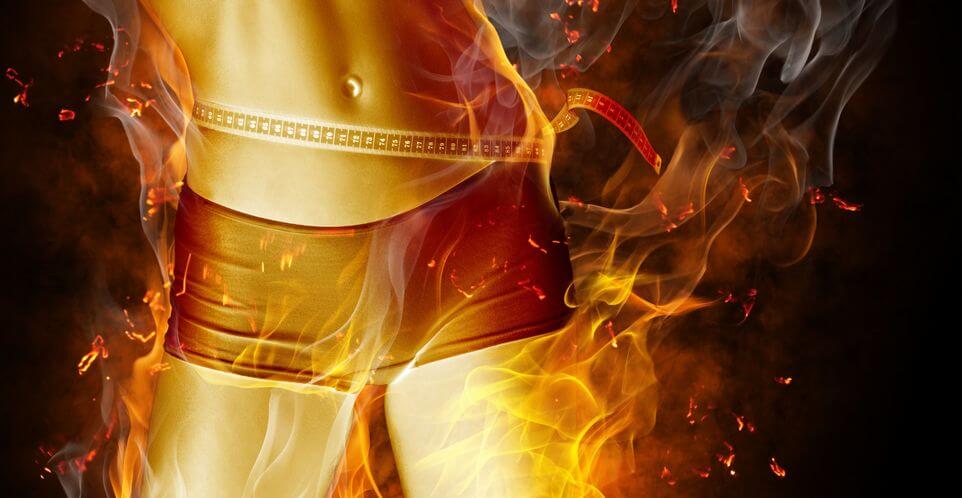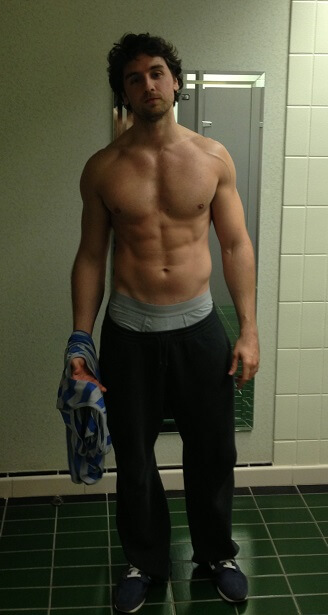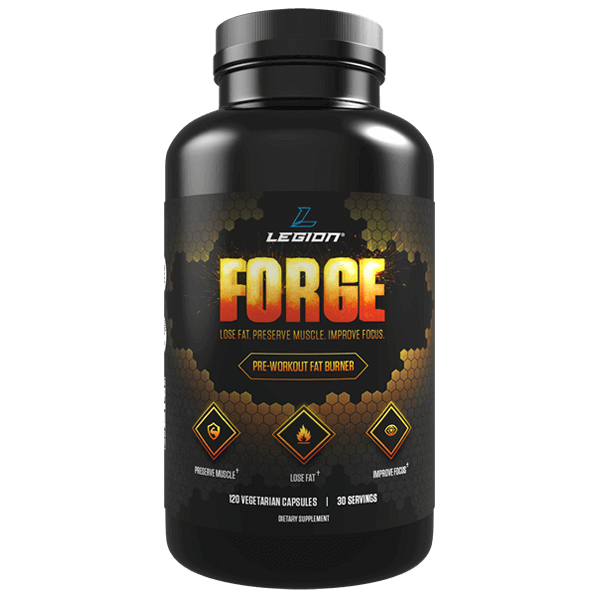Did you know that certain fat cells in your body are extremely “resistant” to being mobilized and burned?
Did you know that these fat cells tend to accumulate in the dreaded belly, hip, and thigh regions of your body?
And did you know that you can use a handful of science-based diet, exercise, and supplementation strategies to beat (and burn!) stubborn fat for good?
Imagine having that tight waist and those washboard abs you’ve always wanted…all year round.
Imagine never again having to suffer through strange diets or grueling workout routines…only to be disappointed in the results.
Imagine knowing which supplements are scientifically proven to help you get lean and which are a waste of money.
Well, you don’t have to imagine these things because I’m going to lay it all out for you in this article.
In just 15 minutes, you’re going to know what makes belly fat so tough to lose and exactly what to do to get rid of it once and for all.
So, let’s start with learning what makes belly fat different from other fat stores in the body.
Table of Contents
Why Belly Fat Is So Stubborn
The 5 Biggest Belly Fat Loss Myths
5 Proven Ways to Lose Belly Fat Faster
My Personal Belly Fat Loss Routine
The Bottom Line on Losing Belly Fat
Why Belly Fat Is So Stubborn
If you’re having trouble losing belly fat, don’t worry…You’re not genetically cursed.
You don’t need to do special exercises.
Your hormones are probably fine.
You’re not eating the “wrong” foods (no, sugar isn’t the problem).
You don’t need to give up carbs.
The reality is you could follow every “thin belly” rule mainstream “gurus” prescribe…perform every “belly flattening” exercise on the Internet…eliminate every possible “hormone clogging” food…bid every form of sugar a sad farewell…and subject yourself to the doldrums of low-carb living…
…and still have handfuls of ugly belly fat for the rest of your life.
It doesn’t have to be like this, though.
No matter your genetics or hormones, you can have the lean, ripped stomach you desire. And it can be easier than you ever thought possible…if you know exactly what you’re doing and why.
And that knowledge begins with a physiological understanding of how “fat burning” actually works.
When we talk about “burning fat,” what we’re actually talking about is a two-part process consisting of lipolysis and oxidation.
Lipolysis is the process whereby fat cells release molecules of stored energy (fatty acids) into the blood and oxidation is the process whereby cells utilize (or “burn”) those fatty acids.
The body’s primary method of stimulating lipolysis is the production of adrenaline and noradrenaline, which are known as catecholamines.
These chemicals enter your blood, travel to fat cells, and attach themselves at certain points known as receptors.
Once they attach to fat cells, catecholamines trigger the release of the fatty acids stored within. Other cells are then able to use these fatty acids as fuel.
Now, all that isn’t exactly news to many people, but most don’t know that fat cells aren’t all made alike. Some respond well to catecholamines and some don’t.
If you’ve dieted for any period of time, you’ve experienced this. Certain areas of your body, like your chest, arms, and face, tighten up quickly but others, like your belly, hip, and thighs, seem to not change at all.
The primary reason for this boils down to one simple fact…
Fat cells contain two types of receptors for catecholamines that are diametrically opposed in function.
These are known as alpha- and beta-receptors and while the physiology is quite complex, it boils down to this: alpha-receptors hinder lipolysis and beta-receptors trigger it.
Thus, fat cells with a high amount of beta-receptors are relatively easy to mobilize whereas those with a high amount of alpha-receptors aren’t.
This is why, when you start a fat loss regimen, you see immediate results in certain areas of your body like your chest, arms, and face, but next-to-nothing in other areas like your stomach, hips, and thighs.
One of the primary reasons why certain fat stores, like belly fat, are so “stubborn” is the fat cells themselves are very resistant to mobilization (they contain many more alpha-receptors than beta).
So, now that you know why belly fat tends to hang on for dear life when you’re cutting, let’s look at some strategies for defeating its “defenses” and burning it away.
The 5 Biggest Belly Fat Loss Myths

If you Google around for belly fat loss tips, you’re going to wind up reading a lot of bullshit.
Here’s a quick antidote…You can’t preferentially “target” belly fat for elimination.
No amount of crunches or planks or anything else are going to directly burn the fat away.There are no individual foods that help or harm the process.
The belly bulge isn’t caused by high-glycemic carbs or “processed foods” or dairy, and no amount of “healthy fats” are going to get rid of it.Your meal frequency isn’t the problem.
Eating many small meals per day doesn’t “stoke the metabolic fire” and eating fewer, larger meals doesn’t send your body into “starvation mode.”Eating late at night isn’t the problem, either.
Eating the majority of your daily calories early or late has no effect on weight loss parameters or body composition.Stress isn’t the culprit.
Stress can promote behaviors that lead to weight gain but can’t directly cause it through hormonal imbalances or any other mechanisms.
Fortunately, losing belly fat is much simpler than many people would have you believe. There are really only two things that you need to know to get rid of ugly belly fat once and for all:
1. You need to reduce your overall body fat percentage.
This is, really, what it all comes down to.
Reduce your body fat percentage to 10% (men) or 20% (women) and the bulk of your belly fat will be gone. And every bit leaner you get from there means even less to pinch on your waist.
2. You can use certain diet, training, and supplementation strategies to help you burn fat faster and mobilize belly fat better.
Given the first point, anything you do that accelerates fat loss in general is going to also accelerate the loss the stubborn fat.
There are, however, a couple specifics things you can do to help your body better get at and get rid of stubborn fat in particular, including belly fat.
Combine both of these strategies–faster fat loss and better fat cell mobilization–and you have an extremely effective stubborn fat loss routine.

If you Google around for belly fat loss tips, you’re going to wind up reading a lot of bullshit.
Here’s a quick antidote…You can’t preferentially “target” belly fat for elimination.
No amount of crunches or planks or anything else are going to directly burn the fat away.There are no individual foods that help or harm the process.
The belly bulge isn’t caused by high-glycemic carbs or “processed foods” or dairy, and no amount of “healthy fats” are going to get rid of it.Your meal frequency isn’t the problem.
Eating many small meals per day doesn’t “stoke the metabolic fire” and eating fewer, larger meals doesn’t send your body into “starvation mode.”Eating late at night isn’t the problem, either.
Eating the majority of your daily calories early or late has no effect on weight loss parameters or body composition.Stress isn’t the culprit.
Stress can promote behaviors that lead to weight gain but can’t directly cause it through hormonal imbalances or any other mechanisms.
Fortunately, losing belly fat is much simpler than many people would have you believe. There are really only two things that you need to know to get rid of ugly belly fat once and for all:
1. You need to reduce your overall body fat percentage.
This is, really, what it all comes down to.
Reduce your body fat percentage to 10% (men) or 20% (women) and the bulk of your belly fat will be gone. And every bit leaner you get from there means even less to pinch on your waist.
2. You can use certain diet, training, and supplementation strategies to help you burn fat faster and mobilize belly fat better.
Given the first point, anything you do that accelerates fat loss in general is going to also accelerate the loss the stubborn fat.
There are, however, a couple specifics things you can do to help your body better get at and get rid of stubborn fat in particular, including belly fat.
Combine both of these strategies–faster fat loss and better fat cell mobilization–and you have an extremely effective stubborn fat loss routine.
10 to 11% body fat

As you can see, this holding a fair amount of fat in the lower ab and oblique regions.
After about 10 to 11 weeks of practicing drop to 6% body fat:

After about 10 to 11 weeks of practicing drop to 6% body fat:

lost little-to-no muscle and am noticeably leaner in core.
So, let’s talk about how I did this and how you can too.
As you know, there are two basic ways to lose belly fat faster:speed up the rate at which you lose fat in general and, help your body better mobilize the fat cells with high amounts of alpha-receptors.
5 different science-based ways to do these things. Let’s talk about each.
So, let’s talk about how I did this and how you can too.
As you know, there are two basic ways to lose belly fat faster:speed up the rate at which you lose fat in general and, help your body better mobilize the fat cells with high amounts of alpha-receptors.
5 different science-based ways to do these things. Let’s talk about each.
1. Utilize a moderately aggressive calorie deficit.
When you’re dieting for fat loss, your goal should be to lose fat as quickly as possible while also preserving your muscle and health.
How well you do this will be mainly determined by the size of your calorie deficit.
That is, a small deficit of 5 to 10% will yield smaller and slower results than a larger deficit of 20 to 25%.
The question, however, is how large of a calorie deficit you can place your body in before problems related to hunger, cravings, and muscle loss really kick in.
Well, there’s a bit of research that can help lend insight.
A study conducted by scientists at the University of Jyväskylä had elite, lean (=< 10% body fat) track and field jumpers and sprinters restrict calories for fat loss for 4 weeks.
All participants exercised on their regular schedule and followed a high-protein diet. One group of the athletes maintained a ~12% calorie deficit, eating about 300 calories less than they burned each day, and another group maintained a ~24% deficit, eating about 750 fewer calories than they burned.
After 4 weeks, the 12% deficit group lost very little fat and muscle and the 24% deficit group lost an average of 4 pounds of fat and very little muscle.
I’ve seen the same type of results with my own body and with many of the thousands of people I’ve worked with.
If you eat enough protein, use weightlifting to drive your fat loss, and keep cardio to a minimum, you can safely maintain a 20 to 25% calorie deficit and maximize fat loss while minimizing muscle loss.
In fact, I’d go as far as saying that larger deficits are necessary for continuing to lose fat as you get leaner and are dealing more and more with stubborn fat. So don’t be afraid of a moderate calorie deficit. It’s a powerful tool for getting lean.
2. Train in a fasted state.

If you’ve ever looked for advice on how to lose fat faster—and especially stubborn hip, belly, and thigh fat—you’ve probably read about exercising on an empty stomach.
According to many experts, training on an empty stomach is a simple but powerful way to increase the amount of fat your body burns while you work out.
There’s truth in this advice, but there’s also a problem: it’s not that simple. How empty of a stomach, exactly? What types of exercise work best? Are there any drawbacks?
Well, the first thing you need to understand is that it’s not enough to simply have a stomach that feels “empty.” This guarantees nothing in the way of accelerated fat loss.
What can help you lose fat faster, however, is training in a “fasted” state, which has to do with the levels of various hormones that affect fat loss, not how empty or full your stomach is.
You see, when you eat food, your body’s insulin levels rise, and it begins breaking down, absorbing, and using and storing the nutrients you’ve just fed it. This is known as the “postprandial” (prandial means “having to do with a meal”) or “fed” state, and it can last anywhere from two to six or more hours, depending on how much and what types of food you eat in a meal.
Eventually, your body finishes processing the food, and insulin levels drop to a low, stable baseline level, where they remain until you eat food again. This is known as the “postabsorptive” or “fasted” state.
Every day, your body flips back and forth between these fed and fasted states. Exercise done while your insulin levels are elevated and your body is still processing your last meal and insulin levels are high is fed training, and exercise done when your body has finished and insulin is low is fasted training.
Now, there’s nothing wrong with training in a fed state. Any exercise burns energy, which supports your weight-loss efforts. What many people don’t know, however, is that training in a fasted state offers several unique fat loss benefits.
1. Research shows that exercising in a fasted state increases both lipolysis and fat oxidation rates.
What this means is that when you exercise with your insulin at a baseline level, your body is able to both mobilize and burn more fat during your workouts than when insulin levels are elevated.
2. Research shows that blood flow in the abdominal region is increased when you’re in a fasted state, which helps you burn the “stubborn” fat in this region.
As you know, one of the problems with stubborn fat, and belly fat in particular, is the reduced blood flow in the regions, and fasted training can help overcome this.
There is a major downside to fasted training, however: it increases muscle breakdown rates.
This is undesirable because if you damage and break down too many muscle cells in your workouts, your body won’t be able to keep up with repair, and you can lose muscle over time.
Another downside to fasted exercise is lackluster workouts. Many people find they have less energy and focus when training in a fasted state and thus aren’t able maintain the level of physical and mental intensity they’re used to.
So, as you can see, fasted training is a double-edged sword. It’s good for losing fat faster, but it’s not so good for maintaining muscle and enjoying your workouts.
Fortunately, you can cancel out these downsides with effective supplementation.
You can neutralize the muscle loss with β-Hydroxy β-Methylbutyrate (also known as HMB). This is a substance formed when your body metabolizes the amino acid leucine, which is an amino acid that directly stimulates protein synthesis.
HMB is often sold as a muscle-building aid but the research purported to demonstrate these benefits is shaky at best, hindered most by design flaws. Thus, I’m not comfortable making any claims about muscle growth.
There is one benefit of HMB that’s well established, however: it’s an extremely effective anti-catabolic agent.
That is, it’s very good at preventing muscle breakdown, which means you will recover faster from your workouts and experience less muscle soreness (and the free acid form shows the most promise in this regard).
It also has no effect whatsoever on insulin levels, which means it won’t break your fasted state like food.
These things make HMB perfect for use with fasted training.
Its powerful anti-catabolic effects and non-existent insulin effects means you reap all the fat loss benefits of training fasted without any of the problems relating to muscle loss or insulin secretion.
It’s also worth noting that HMB is superior to leucine in suppressing muscle breakdown because it’s more anti-catabolic than its “parent” amino acid.
This means it’s also more effective than branched-chain amino acid (BCAA) supplements because they rely on leucine for their anti-catabolic effects (isoleucine and valine are very weak in this regard).
Clinically effective dosages of HMB range between 2 and 3 grams, and that’s what you’ll find in my pre-workout fat burner FORGE:

FORGE also contains a clinically effective dosage of yohimbine, which improves workout performance and directly helps with stubborn fat loss (we’ll talk more about it soon).
3. Strategically use cardio to burn fat faster.
The best way to include cardio in a weight loss regimen is to do as little as needed to reach your desired rate of weight loss and stay fit, and no more.
For best results do . . .At least two low- to moderate-intensity cardio workouts per week of 20-to-40 minutes each.
The best way to include cardio in a weight loss regimen is to do as little as needed to reach your desired rate of weight loss and stay fit, and no more.
For best results do . . .At least two low- to moderate-intensity cardio workouts per week of 20-to-40 minutes each.
One HIIT workout per week if you enjoy it.
No more than 2-to-3 hours of cardio per week.
Cardio and weightlifting on separate days. If that isn’t possible, lift weights first and try to separate the two workouts by at least 6 hours.
Although you’ll often hear fitness gurus tout HIIT as the most effective kind of cardio for fat loss, this isn’t true. Moderate-intensity, steady-state cardio is just as good at fat-burning, easier to recover from, and doesn’t sap your motivation or energy as much as HIIT, which is why I recommend you do it for the majority of your cardio workouts.
4. Lift heavy weights.

If you’re familiar with my work, you know that I’m a big proponent of heavy, compound weightlifting.
This type of training offers two big fat loss benefits.
1. It helps you preserve your strength while in a calorie deficit, which in turn helps you preserve your muscle.
2. It dramatically increases your basal metabolic rate for several days after each workout, and research shows this type of training can result in hundreds of more calories burned than workouts performed with lighter weights.
Another noteworthy benefit of heavy, compound training is the simple fact that most people find it more enjoyable than high-rep, “feel the burn” workouts, and more enjoyable workouts means better long-term compliance and progression.
3. Take supplements proven to impact fat loss.
Supplements aren’t the key to fat loss, but if you combine the right ones with a proper diet and exercise routine, you can dramatically speed up the process.
Caffeine
Millions of people can’t shake the cobwebs without their morning cups of coffee but this powerful compound has a lot more going for it.
Caffeine helps you lose weight by increasing the amount of energy your body burns throughout the day, and it also improves strength, promotes muscle endurance, and enhances anaerobic performance.
For best results, research has shown that caffeine is best delivered in a pill or powder format, though you must be careful to avoid building up a tolerance to it.
Then do 20-to-40 minutes of low-to-moderate-intensity cardio on the recumbent bike and eat dinner after, followed by about 40 grams of protein an hour or so before bed.
The Bottom Line on Losing Belly Fat

Millions of people are struggling to lose belly fat and resorting to all kinds of weird diets, supplements, and “flat belly tricks.”
It doesn’t have to be that way. For anyone. Ever.
If you take the simple actions laid out in this article, you can get that lean, rippling six pack you’ve always wanted and keep it for the rest of your life.

ليست هناك تعليقات:
إرسال تعليق